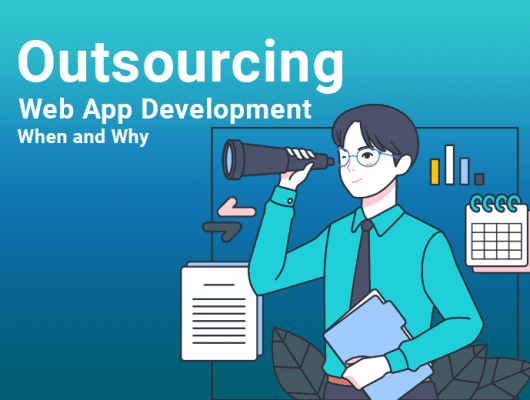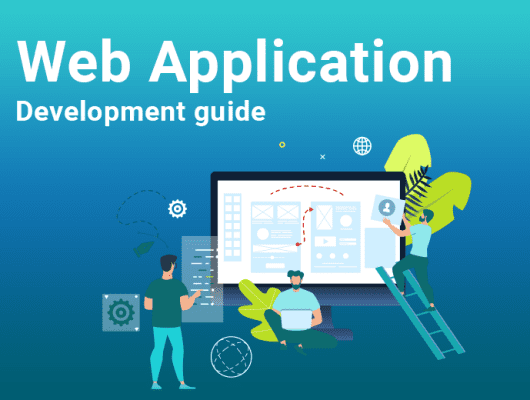
Web Development: When, Why, and How ( All You Need To Know)
With the increase in the usage of web apps, understanding its development is vital for software developers and organizations.
So, what motivates the demand for web app development, and how can one successfully negotiate this challenging industry?
If you are struggling with these questions, You are not alone. Many people want to know “when,” “why,” and “how” to flourish in this competitive field.
Fortunately, the answers to these questions are within your reach. This comprehensive guide delves into the intricacies of web development, offering insights and practical strategies.
So, let’s step into it to unlock the secrets to mastering web app development, ensuring your projects stand out.
However before we begin let’s understand what is web application development
Table of Contents
A. What Is Web App Development?

Web app development is the process of creating web apps that run on a server and users can access through web browsers. This process encompasses the
- Creation
- Refinement
- Evaluation
- Implementation of web-based systems
B. What Is A Web Application?
If you’re unfamiliar with web applications, here’s a definition:
A web app is a computer program made with HTML, CSS, and JS.
It allows users to perform various tasks over the internet by storing and changing data through databases and files.
C. Web App Vs. Websites
Web applications revolve around input, explicitly creating, reading, updating, and deleting data.
Websites, on the other hand, have distinctive content. You can get different information on social media from a site, like news, ads, and FAQs.
1. When To Opt For Web Development?
Building a web application is a strategic decision. However, the right time to do so depends upon various factors
i) User Demand
The best time to go for web development is to understand the needs of market and user demand. You can do it by analyzing customer feedback, conducting market research, or identifying the gap within the current services.
For example, there is increasing demand for entertainment apps that help people make their leisure time fun. Therefore, understanding and taking the instant steps assist in assuring the app contains already engaged users.
ii) Maintaining The Budget
Suppose you want to cut off the additional cost while making your mark in an online market. Then, the wisest option is to develop a web app because creating one eliminates unnecessary expenses, such as
- Frequent device updates
- Maintenance of numerous devices
- Hardware purchases.
Iii) Business Strategies And Goals
If you consider that web development helps in achieving your business goals, like
- Ensuring customer satisfaction
- Improving the quality of provided services
- Providing your revenue with the new opportunity.
Then, consider it a fortunate time to develop an app.
iv) Technological Advancement
The emergence of innovative technology and the framework make web development more practical and cost-effective. For example
Technology like cloud computing has significantly altered how web apps are hosted. It helps to reduce infrastructure costs and complexities.
V) Competitive Environment:
Keeping ahead of competitors is vital for being the talk of town. Suppose you consider your competitors gaining market advantage by web development. In that case, it is essential because it helps you overcome a downfall in service delivery, customer engagement, and technological innovation.
Vi) Availability Of Resources:
The right team and resources significantly contribute to the success of web app creation. Therefore, before commencing the web development process, ensure that you have
- An expert team of developers
- Experienced maintenance staff
- Advance technology
- Proper pre and post-launch services.
vii) Scalability and Flexibility needs:
If your business needs to fail to adapt to current technological trends. Then, the most robust solution is to opt for web app development. These apps can easily handle an increased amount of data and users. Moreover, you can easily update them as per the market trends.
2. Why To Develop a Web app?
As people widely use the internet, they are increasingly considering web apps essential. Therefore, here are several reasons that will help you understand its importance.
i) Easier Access, Wider Reach
Web applications are accessible globally with a proper internet connection. It enables businesses to connect with millions of customers without location restrictions.
ii) Rapid Deployment
Web development plays a crucial role in helping businesses expand their reach and introduce new products or services. They offer a platform that fosters innovation and enables companies to stand out in a highly competitive market.
iii) Cost-Effectiveness
Web applications are often more budget-friendly options compared to traditional desktop software. Overcoming the need to distribute and update software on individual machines significantly reduces maintenance costs.
iv) Enhanced User Engagement Through Responsive Design
Thoughtfully crafted web applications provide a smooth and intuitive user experience. It helps to increase engagement, customer satisfaction, and brand loyalty.
v) Enhancing Efficiency
Web applications can automate various processes, resulting in a reduction of manual efforts and a significant improvement in overall efficiency.
Statista predicts that the worldwide web app development market will reach $167 billion. The expansion continues to grow at a rate of 7.04% each year, resulting in a market worth $234.70 billion by 2028.
3. How To Build A Web Application From Scratch

Building web apps involves a variety of processes. Here is a summary of the various steps involved in the web development process.
A. Planning and Strategy
Designers create mobile web applications to address various challenges. To fully grasp the app’s goals, audience, and other important elements, carefully examine and plan the outline. Here are the steps involved in the planning.
i. Defining Objectives and Target Audience
Not every business idea requires an app. So, conducting thorough research before diving into any project is essential.
- Start by clearly identifying the problem you want to solve, then explore various potential solutions.
- Speak with individuals who have encountered the issue and inquire about any possible solutions they may have.
- Explore alternative solutions to address the problem.
- Understanding the user and the competition is crucial for shaping the technical direction of the web app.
ii. Choosing the Right Web Development Framework
Understanding the importance of the web framework enables you to prioritize the essential elements that will enhance user preference.
When developing your web app, it is crucial to prioritize the user experience for managing essential items such as
- Payments
- Passwords
- Contact lists.
Consider this scenario: You’re working on a web app for a retail home décor company. The main goal is to make the buying experience more efficient and to store past customer purchase data.
To do this, pick the right framework to improve the checkout process and make sure users have a good experience.
Find out more about How To Make A Social Media App.
B. Web Application Development Process
After collecting the information, you must now create a plan that outlines the structure of the web application. So,
- Come up with the online app’s user interface (UI) and user experience (UX).
- Make wireframes, prototypes, and mockups to see how the style and interactions will look.
- Make system diagrams, data paths, and database schemas.
Moreover, the duration of this stage varies depending on the level of complexity of the web application. However, it usually takes two weeks to create an MVP mobile application.
In addition, to give you a clear understanding, we divide the development process into three parts.
i. Development Of The Front End
Frontend web development is an essential aspect of building user-friendly and visually appealing websites. It involves
- Use HTML, CSS, and JavaScript.
- Putting the UI concept into action, ensuring it includes responsive layouts and interactive parts.
- As needed, add frontend tools and libraries.
ii. Development Of The Back End
Backend development is essential to building a robust and functional software application. It involves using the chosen computer language and framework to build the
- Business logic, server-side logic, and APIs. For example, you could use Python with Django or Flask, Node.js with Express, Ruby on Rails, or something else.
- Set up security, verification, and permission processes for users.
- Make RESTful or GraphQL APIs so the front and back end can collaborate.
iii. Building Databases
To ensure a streamlined function of your web app, build a database.
- Plan and create the database design based on the application’s data needs.
- Pick a sound database management system (like MySQL, PostgreSQL, or MongoDB) and set up the database.
- Carry out tasks for storing, retrieving, and changing data.
C. Testing
Testing your web app is an ongoing process that usually occurs during and after the building phase. It includes different types of testing, such as unit testing, integration testing, and user acceptance testing.
Each ensures proper application functionality, performance, security, and interaction on various browsers and devices.
D. Integration
Incorporate third-party services, APIs, and libraries to improve the application’s functionality. These can include payment gateways, social media integration, and geolocation services.
E. Deployment
When deploying your web application, you have a few options to choose from.
- You can consider deploying it to a production environment such as a web server, cloud platform, or hosting service.
- Set up server configurations and domain names and implemented security measures like SSL/TLS certificates.
- Implement monitoring and error-tracking tools to guarantee the stability of the application.
F. Keeping Things Running Smoothly
Updating and maintaining the application is essential, which involves:
- Addressing any bugs
- Addressing any bugs
- Implementing security patches
- Adjusting the application’s capacity to handle higher user demand and traffic levels.
G. Activities After the Launch
- Efficiently market and promote the web application to attract users and encourage active engagement effectively.
- Gather user responses and scrutinize data to make knowledgeable choices for upcoming upgrades and improvements.
4. Core Aspects of Creating Web Applications
To understand the web development process properly, here are core aspects to take into account.
i. Client-Side Development
It focuses on creating the web application’s user interface (UI) components. Client-side development involves using
- HTML to structure content
- CSS for styling
- JavaScript for dynamic and changing operations.
ii. Server-Side Development
The main focus of server-side development is the construction of the web application’s backend. It encompasses the development and execution of
- Logic of the server
- Administration of the database
- User identification and corporate regulations.
Moreover, developers use several popular programming languages for server-side development, such as Python, Ruby, Java, PHP, and Node.js.
iii. Databases
Web applications commonly rely on databases to store and manage data efficiently. They play a crucial role in ensuring
- Data integrity and security,
- Designing and implementing database schemas
- Creating queries to retrieve and manipulate data.
iv. Frameworks and Libraries
Developers utilize frameworks and libraries to optimize the development process and adhere to industry standards. These tools offer a wide range of pre-built components, structures, and patterns to assist with various tasks, such as
- Routing
- Managing Security Data.
5. Exploring Programming Languages for Web App Development
Various programming languages are available for web application development, each offering unique strengths, frameworks, and ecosystems.
However, choosing a programming language involves considering various factors.
- Project requirements
- Team expertise
- Scaling needs
- Personal preferences.
Following are a few widely used programming languages for web development:
i. JavaScript
JavaScript is a widely used programming language essential for building interactive websites and web applications.
It allows developers to add dynamic elements to their web pages, such as animations and user input validation.
Most importantly, JavaScript plays a crucial role in frontend development. It enables the creation of interactive and dynamic web interfaces, seamlessly integrating with HTML and CSS.
ii. Python programming language
Many people widely recognize Python for its simplicity and readability. Developers commonly use it in backend, front end, and full stack development alongside frameworks like Django and Flask.
iii. Ruby
Ruby is a programming language that is easy for developers to work with. Ruby on Rails expedites development and promotes the adoption of best practices.
iv. Java
Many people widely recognize Java for its robust reliability and ability to handle large-scale operations. Enterprise-level applications frequently use it, often in conjunction with Spring and Java Server Faces (JSF) frameworks.
v. PHP
PHP is popular for web development, particularly when creating dynamic content. Developers commonly use it in conjunction with the Laravel or Symphony frameworks.
vi. Rust
Rust is becoming increasingly popular because of its emphasis on safety and performance in backend development. This technology is ideal for creating web applications, mainly when there is a strong emphasis on security.
vii. Golang
Many people widely recognize Go for its exceptional performance and efficiency in backend development. Companies commonly use this technology to develop highly scalable backend systems and APIs.
viii. C# / ASP.NET
C# is a common language utilized in web development alongside the ASP.NET framework. Developers prefer it for creating Windows applications and services.
ix. Typescript
TypeScript is a programming language that builds on JavaScript by adding static types. It provides a way to catch errors and bugs during development, making writing reliable and maintainable code easier.
TypeScript also offers features like interfaces, classes, and modules, which enhance code organization.
6. Exploring Web App Development Frameworks
Web application development frameworks offer a well-structured and organized approach to constructing mobile web applications.
Frameworks simplify web development by offering pre-built components, libraries, and tools. They promote best practices and help developers create robust and manageable applications.
Here is the list of widely used web application development frameworks:
i. Spring Boot
A robust framework that enables the development of web applications using Java. The configuration and setup process is more straightforward, allowing the developers to concentrate on writing code.
ii. Laravel (PHP)
A PHP framework that focuses on enhancing developer productivity and ensuring a user-friendly experience. The software provides a range of features, including an ORM, verification, and routing.
iii. ASP.NET (C#)
Microsoft has developed a robust framework for creating web applications using C#. This comprehensive package offers many tools, libraries, and components for building scalable and secure applications.
iv. NestJS
A framework for building efficient and scalable server-side applications using Node.js and TypeScript. An advanced Node.js framework is often designed for creating high-performance server-side applications.
v. Ruby on Rails (Ruby)
Rails is a framework for making web apps with databases using the Model-View-Controller pattern. The most potent framework that excels in meta programming and database-oriented web programming.
vi. Flask (Python)
Introducing a Python micro web framework that is lightweight and easy to use. Developers can choose the best components for their needs, making it great for small to medium-sized projects.
vii. Angular (TypeScript)
Google maintains a frontend framework to create dynamic single-page applications (SPAs). It provides robust data binding, a flexible component architecture, and efficient dependency injection.
viii. React (JavaScript)
React is a powerful tool that allows developers to create user interfaces using JavaScript.
- It is Recognized as the leading frontend framework among developers.
- Highly compatible with extensive web projects.
- Beneficial in use for small to medium-sized projects.
ix. JavaScript framework Vue.js
Vue is small and easy to learn, making it good for different project sizes. Using it in a project can also be relatively simple and beneficial.
7. Advanced Concepts in Web App Develop
To better understand mobile web app development, here are additional concepts as well. Such as
i. Progressive Web Apps
Progressive web applications are modern web applications that mimic and often surpass the performance of native applications.
Web applications of this nature operate using a distinct approach and incorporate technologies like
- Service workers
- Manifests
- Push notifications.
You can download and save progressive web apps on your home screen for easy access and a native-like experience. Unlike web applications, you can also use them offline.
ii. Accelerated Mobile Pages (AMP)
AMP is an open-source project that makes web pages load fast on mobile browsers. Creating AMP versions of your landing pages can significantly enhance the mobile user experience.
8. Importance Of Applications In The Current Digital Landscape
In today’s digital age, app development plays a crucial role because of the widespread use of the internet. Therefore, understanding the importance of creating a mobile website app is essential for several reasons:
- Web applications have the advantage of being accessible from different mobile platforms using the internet.
- It helps businesses expand and introduce new products to customers.
- Thoughtfully designed web applications provide a smooth and intuitive experience for users.
- Web applications streamline processes, minimizing the need for manual intervention and maximizing productivity.
9. Web App Examples
Here are a few examples that help you to understand mobile web applications.
i. Mailchimp
Mailchimp is a platform that focuses on email marketing and offers marketing automation services. A sophisticated web application with an intuitive user interface ensures a user-friendly experience.
ii. Google Docs
A widely used online document editing and collaboration tool. It allows users to create, edit, and store documents online, making it convenient for personal and professional use. With Google Docs, multiple users can work on the same document, making collaborating and sharing ideas super easy.
iii. The notion
Notion is a comprehensive web application that allows users to take notes, collaborate with others, and utilize markdown formatting.
iv. Xero
Xero is a cloud-based accounting software. It offers a range of features and tools to help streamline financial processes and improve efficiency. It helps to manage invoices, track expenses, reconcile bank transactions, and generate financial statements.
Wrapping Up
With the increasing production and advancement of technology , there is a greater demand for web apps. These apps should be efficient, user-friendly, and high-performing.
Prioritizing the intelligent and efficient development of these applications is of the utmost importance. So, it is essential to find a trustworthy app developer or business.
Therefore, to get high-quality web applications, consider picking Onyxtec. Here, our team of experts excel their expertise in creating seamless, user-friendly app design and functionality. The best is? obtaining your app won’t cost you a dime in overhead.
So, what are you waiting for? Get your user-friendly app at a highly affordable price, by contacting Onyxtec.
FAQ
Is it possible to build an app without experience?
Yes, you can build an app without learning the coding with the help of a reliable app builder.
How to build a web application from scratch with no experience?
- Create a roadmap for your web idea
- Research about the current market
- Understand and define the core functionality of your app
- Choose the right app developer partner
- Design wireframe and prototype
- Developing the app
- Testing and launching
- Gaining feedback for improving your app performance.




